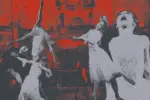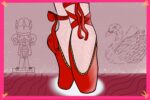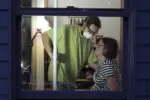On a chilly afternoon in Southeast Michigan, a small group of masked Oakland University students gathered on campus to celebrate the end of a particularly difficult semester. Staff and students alike had been noticing heavy burnout like never before. Miraculously, they have made it through a pandemic, political strife and intense periods of televised racial injustices. The exhausted people of the Oakland University community needed a lighthearted event to get involved in — something uplifting that permitted them to enjoy themselves while celebrating their accomplishments and those of their peers. So, they fired up a stereo, made some posters and commenced with their dancing.
The dance party was intended to lift the discouraged spirits of the Oakland University community. While it’s important to count one’s blessings during these unprecedented times, people need to realize that health is not just the lack of illness but the combination of mental, physical and social well-being. Dancing can aid all three aspects of health.
A 2010 study surveyed 475 non-professional dancers and tracked their dance habits; it discovered that dancing resulted in an overall improvement of each subject’s self-esteem, confidence and overall mood. According to the Better Health Channel, people who dance have better management of their weight as well as high strength, agility and flexibility. Dancers have improved bone, heart and lung health, which lowers the risk of cardiovascular diseases and osteoporosis.
For these reasons, doctors and psychologists have incorporated dance as therapy for Parkinson’s disease, neurotrauma, depression, arthritis, cancer and fibromyalgia. Moving rhythmically with others and expressing oneself through dance can also help one build social relationships, creating a well-rounded state of health.
Uniting with others — especially strangers — is a deeply humanizing experience, but it is sometimes viewed as a revolutionary act. The art of dancing traces back to ancient drawings of figures on rocks that are at least 9,000 years old. Historically, native cultures have performed music and dance rituals for celebration and spiritual awakening. The Indigenous and African dancers, however, were chastised and demonized as savages.
Similarly, an infamous group of female devotees called maenads participated in dance rituals to honor Dionysus, the Greek god of wine and festivity. Caught in a frenzied state of mind, they would catch animals, tear them limb from limb with their bare hands and eat them ravenously. Unsurprisingly, white Europeans went to great lengths to suppress these cultural dances.
Those who didn’t immediately write off dance as lustful and demonic found immense power in the euphoric feeling that dancing offers. It’s no wonder that people began to dance with their community as a form of protest. This idea likely began hundreds of years ago, but it started to gain traction in the 2010s as a response to police brutality against people of color. Dance became an expressive medium that allowed people to communicate when language failed to describe the extent of their emotions. It can be difficult to describe with words the heartache and betrayal people feel when they see injustices in their daily lives.
Rather than committing violence, dancing connects diverse communities and offers expression to those who have been wronged by society. “Dance has nothing to do with what you can say with words, but what can be done with actions,” wrote Dana Mills, author of “Dance and Politics: Moving Beyond Boundaries.” Creating a community that encourages the freedom of expression also fosters a space for people to engage in activism and political commentary.
Unfortunately, nonviolent protests such as dance events rarely make it into the news; they are buried under dreadful stories of school shootings and homicides. News reporters ignore heartwarming stories of how communities work together to bring awareness to pressing issues. In highly opinionated and biased news sources, nonviolent protests are only reported on when they are connected to violent protests.
A FOX 5 article by Catherine Park begins by commending the dance protestors, who were protesting after George Floyd’s death, for remaining peaceful and walking side-by-side with law enforcement, but the report quickly turns pessimistic. “Peaceful protests involving tens of thousands of people on Saturday gave way, in some places, to rioting, looting and violence, with police vehicles torched, stores emptied and objects hurled at officers,” Park writes, abandoning her seemingly peaceful title. Whether they commit any acts of violence or not, people who practice their right to protest are put down by biased news sources.
Some groups of people come to the streets specifically to disrupt traffic and bring back a sense of joy to the very setting where racist authorities have murdered Black people — George Floyd, Trayvon Martin and Eric Garner. These street dances are typically choreographed, such as the group performance of the Cupid Shuffle in Newark and the Electric Slide in Harlem. Jo’Artis Ratti and several other demonstrators protested police brutality with a dance called the Krump. Krumping is a highly expressive dance style characterized by sharp and vigorous body movements, allowing dancers to demonstrate the kind of violence that is being done to the Black community.
Other people who attend dance protests find themselves dancing more spontaneously — a movement born of the collective joy in the streets. At many Black Lives Matter protests, participants marched, clapped and shook their fists as the music swelled behind them. At the heart of dance protests lie people who express their pain and joy simultaneously, pronouncing their existence in the world and demanding justice for all.
The pandemic and several school shootings have caused educational communities to fear coming onto campus. Not only are people fighting to keep afloat, but no one is seeming to take notice. Their efforts are invisible to others, and they feel forced to struggle alone. At Oakland University, there are several ways to combat the anxiety and depression that students and staff are feeling, yet the administration is neglecting to offer sufficient assistance or even recognize their students as individuals, not just numbers in a system. Rather than taking the time and effort to acknowledge their community, the institution introduced steep increases in tuition and cut benefits to already underpaid and undervalued staff.
On Thanksgiving morning, the administration reminded everyone what they were really thankful for — the expensive university president’s house and the lavish dining room table. A house tour video was sent to all staff and students in a tasteless and tone-deaf email, which felt especially inconsiderate of those who can barely afford to pay their way through college. This was the breaking point for Oakland University students. They needed more than just acknowledgment of how hard this year has been and more information on how the university is going to prioritize their physical and emotional health. Since the university was not going to celebrate the accomplishments of their staff and students, they took it upon themselves to do so together.
As the Elliot Tower’s clock struck 1 p.m., the official dance party began. Hits from bands such as Queen, Kool & The Gang and Journey got people up and moving. Other songs like Whitney Houston’s “I Wanna Dance With Somebody” and “Dancing in the Street” by Martha Reeves & The Vandellas were played to put people in the dancing mood. Dancing participants cheered to onlookers, encouraging them to release their inhibitions and join in on the party. Some offered their support by smiling, laughing and nodding to the beat while others walked past with their eyes trained on the ground. Those who chose to join were inspired to show off their freestyle moves and join in on choreographed numbers to “Y.M.C.A.”
What good comes out of an undergraduate student’s idea for a dance party? Is it even appropriate to dance while the world is on fire, teeming with deadly viruses and human rights violations? Dance protests are often criticized as being “distractions from the serious political work” and not carrying enough political weight. Did the dancing of Oakland University students do any political work?
Naturally, these students would love to do more than just have a dance party to generate conversations about the treatment of students and staff at Oakland University and other institutions around the world. More than anything, though, they wanted their peers to know that they were not alone in their struggles. While individually, everyone battles with their own issues like social isolation and depression, made more prominent by the COVID-19 pandemic, there is always a community of people similarly struggling that you can connect to.
While a dance party at Oakland University may not solve these dire, grand-scale problems, these explosions of gender, race, sexuality and class bring people together. Hierarchies in school administrations, the government and societies are about exclusion, but festivity generates inclusiveness. During a dance party, we allow ourselves to step out of our assigned roles and into a space defined by diversity, creativity and equality. If it gave hope and joy to the people passing by, even if only for a fleeting moment, then the dance party was successful in its efforts.

















